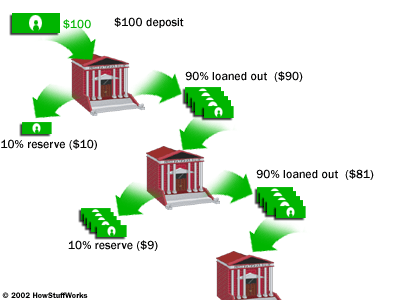 Please see related posts: Lord of the Rates Part I – One Rate To Rule Them All, and Part III and Part IV.
Please see related posts: Lord of the Rates Part I – One Rate To Rule Them All, and Part III and Part IV.
Interest rates in the US are going up soon (maybe September? maybe June?), so what will that do to the money supply?
As the ancient text translated from Isildur bane says:
Three rates for mortgage brokers under the sky
Seven for the bankers in their halls of stone
Nine for consumers doomed to die
One for the Yellen on her dark throne
In the land of FOMC where the money’s born
One rate to rule them all, one rate to find them,
One rate to bring them all and in the darkness bind them
In the land of FOMC where the money’s born.
Printing money
Economists don’t like to say that the Fed ‘prints money’ since the physical act of manufacturing bills and coins has very little effect on the actual money supply available in the US Economy. The US Mint, not The Federal Reserve, creates physical coins and bills.[1]
The Fed funds rate and the open market operations used to enforce the Fed funds rate, plus the market-based reactions of large banks to those interest rates, plus the invisible hand of separate self-interested actions by borrowers in an economy, is really how the Fed ‘prints money’ when it wants to increase the money supply.
In an important sense, private banks are the ones who really ‘print money,’ with the Federal Reserve’s agreement and nudge, when they make loans to businesses, governments, and consumers through our system of ‘fractional reserve banking.’
‘Fractional reserve banking’ kind of works like this: At any given time period, a bank needs to keep available in cash only, say, 10% of its total deposits, while the other 90% is available for investing or lending.
So with your $1,000 CD for 1 year that you opened, your bank actually plans to lend out $900 of that while keeping only $100 on hand as a ‘fractional reserve’ of your CD deposit.
When your bank lends $900 to the local coffee shop,[2] the $900 is really almost like ‘printed money,’ sort of, kind of, invented by the bank out of thin air. How’s that?
You deposited $1,000, and that money still exists as yours, or at least will exist for you in a year from now. The coffee shop meanwhile has use of $900 for its own purposes. When the coffee shop then deposits, for the meantime, the proceeds of its $900 loan into its own business bank, the ‘fractional reserve banking’ system keeps on going, inventing more money.
The coffee shop’s bank can take the $900 deposit, and lend out $810 of that again to another business (again retaining the $90, or 10% fractional reserve.) Continuously lending 90% of deposits is how private banks and the borrowing customers’ create money’ in an economy.
With low interest rates and lots of borrowing in an economy, the original $1,000 CD gives birth to much more money circulating in the economy, first $900, then $810, then $729, then $656, etc.
As long as lots of businesses, governments and consumers want to borrow money – and they generally want to borrow more when rates remain low – the money supply grows via this fractional reserve banking system.
The Fed funds rate
Returning to the role of the Federal Reserve in this process: To the extent the Fed funds rate remains low, a private bank can access money cheaply and make money relatively easy for its borrowers to access.
As long as borrowers have a need for capital, the money supply grows easily in response to economic activity, when Fed funds and other interest rates in the economy remain low.
By contrast, when the Fed funds and other interest rates rise – as they are about to do, soon – a reversal of the fractional reserve lending process occurs. As interest rates rise, fewer business and consumer borrowers may find it profitable or attractive to take out loans, thus slowing the growth of the money supply.
If interest rates rise enough, they effectively reverse the ‘money printing’ of a fractional reserve system. The coffee shop doesn’t want to borrow the $900 in the first place any more, and all that later money ($810 + 729 + 656, etc) remains ‘unborn’ as well.
That’s good for limiting the money supply and therefore inflation, but also risks choking economic activity if an interest rate hike is too high or too fast, relative to the economy’s natural demand for money.
Anyway, in simplest form, that’s the mechanism of how the Fed – via the Fed funds rate, the actions of banks, and subsequent actions of borrowers – determines the money supply.
Please see related posts:
LOTR Part I – One Rate To Rule Them All
LOTR Part III – Fed Funds, Mortgage and Real Estate Markets
LOTR Part IV – Fed Funds Effect On Consumer Rates
[1] For a little tangential info on the profitability – via seigniorage – of The Mint when it does create coins and bills, see this note on why I use dollar coins.
[2] Can you guess where I wrote this?
Post read (1797) times.






